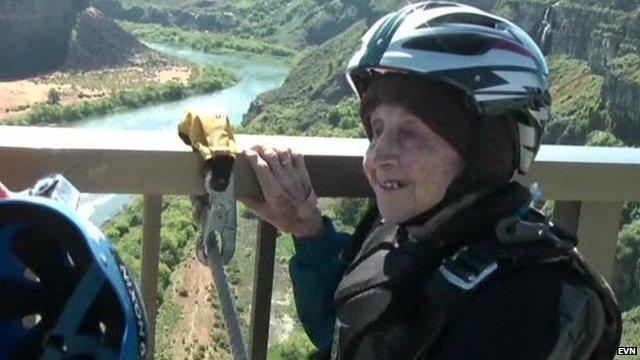The girls base jumping off cliffs in the Swiss Alps
- Published
Base jumpers insist safety is paramount to the sport, as Imogen Foulkes reports
On a beautiful day in early summer, Justine Edde and Ellen Brennan are heading up into the Swiss Alps.
The Lauterbrunnen Valley is one of their favourite spots, but they love it not because of its carpet of wild flowers, rushing streams and snow-covered peaks soaring into the blue sky.
They love it because of its sheer, vertical cliff walls, rising 700m (2,300ft) and more from the valley floor.
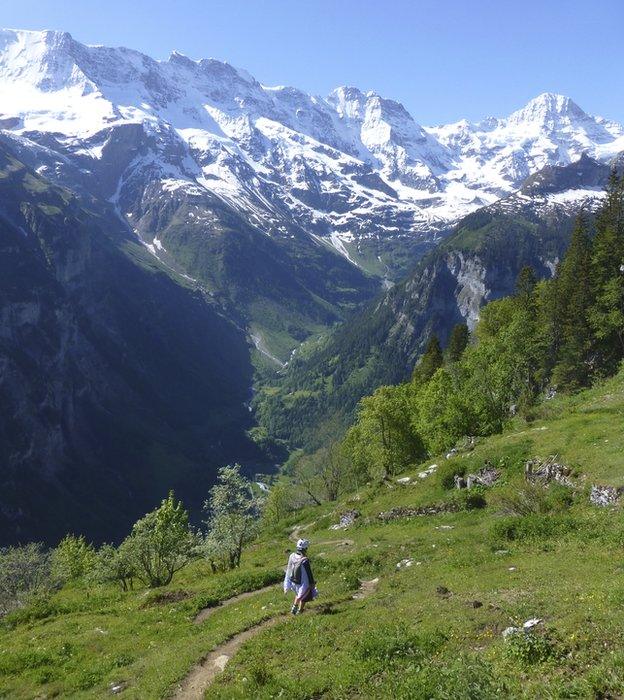
The alps attract fans of adventure
"I'm a base jumper," explains Justine. " I love the mountains, and I like to jump as often as possible. Some people play tennis or golf, I like to go jumping."
BASE stands for 'building, antenna, span, earth' - the four fixed structures base jumpers can jump from. Most, like Justine and Ellen, got into the sport through skydiving first, and graduated to base jumping, which is considered technically more difficult than skydiving from a plane or helicopter.
Their planned jump today is easily accessible, and of course cheaper than booking a place in a plane to skydive. A few minutes on the cable car, a few minutes easy walking, and Justine and Ellen have reached the edge of the cliff. A small fence separates the jump-off point from the path, and beyond it, a short walkway like a diving board juts out into the void.
The view down into the valley is dizzying, and not for anyone who suffers from vertigo.
Base jumper Justine Edde takes us with her on a 700m jump in the Swiss Alps
Dream or nightmare?
For many people, the prospect of jumping off here is the stuff of nightmares. For Ellen and Justine, it is more like a dream come true.
"This is not the nightmare of falling," Ellen explains, "it's the dream of flying. People have dreamed of being able to fly for generations."
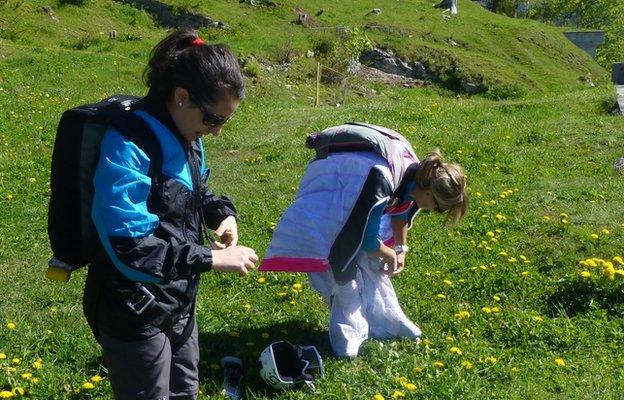
Ellen and Justine prepare for the jump with helmets, parachutes and a wingsuit
Both women are meticulous in their preparations for their jump, checking and double checking their equipment.
They each wear helmets, and parachutes which they will open as they approach the valley floor.
Ellen is also wearing a bright pink wingsuit, with extra fabric between the legs and under the arms. It is designed to help her 'fly' for longer before opening her parachute.
They are not alone; there is a queue of people at the cliff edge, waiting to jump. Some go in pairs, so that one can film the other with a GoPro wearable camera as they go down. Justine and Ellen choose to go individually, with Ellen going first.
She walks confidently out to the edge of the walkway, has a last look at her equipment, whispers "three, two, one" to herself, and then she is gone, sailing down into the valley.
Justine follows. She hesitates a little longer before jumping, and then she too disappears into the void, the only trace of her a squeal of exhilaration as she, without a wingsuit, plummets down headfirst.
Both can expect a free fall of 20 to 30 seconds before they must open their parachutes if they are to have a safe landing. Both must be intensely focused on the wind conditions, and the proximity of the cliff face: a single gust, a single wrong move could mean the end.
'Death Valley'
It is a high-risk sport, and there have been many accidents, leading Lauterbrunnen to be dubbed "death valley" by the Swiss media. Farmer Matthias Feuz, whose fields are directly below the jump-off point, has personally witnessed deaths.
"I heard a loud bang. A base jumper had crashed into the rock face several times, fallen to the bottom of the cliff and died there," he told Swiss television.
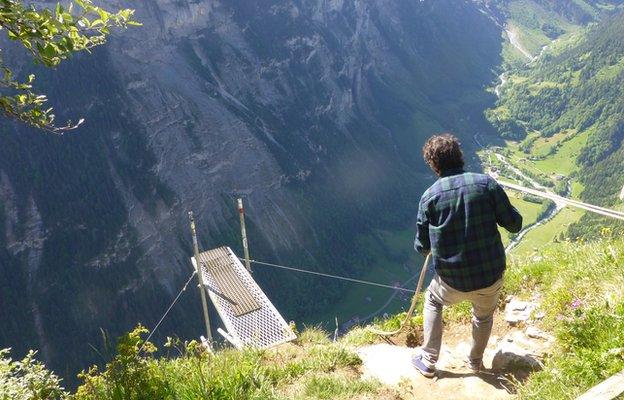
The view into the valley is not for the faint-hearted
"It was the most horrible experience of my life, watching someone die right before my eyes. I felt sort of angry that someone could put their life on the line like that for just a few seconds of thrills, that they didn't have more respect for their own lives."
Mr Feuz has called for base jumping to be banned, but other farmers in the region are more philosophical about the sport.
Adolf von Allmen has seen plenty of accidents, and has come to the conclusion that it's not up to him to worry about it.
"I'm really trying not to let it bother me," he said.
"When I see how the jumpers deal with it - their friend dies in the morning, they are back jumping in the afternoon. So I'm beginning to think my grief for them is inappropriate."
More rules?
Nevertheless, four deaths in a single week in April have raised questions about whether base jumping, and wingsuit diving from planes, should be better regulated.
In many countries base jumping is forbidden, but in Switzerland the sport is only loosely regulated through a series of recommendations developed between the Swiss Federal Aviation Office and the Swiss Base Association.
Jumpers are supposed to have a skydiving licence, and they are advised to complete at least 200 dives before they attempt base jumping.
It is also recommended that they have insurance, and, in Lauterbrunnen, they are supposed to buy a "landing card" (costing $25 a year), which compensates local farmers for the damage done to pastures during landing.
In practice, such recommendations are very difficult to enforce, because there is really nothing to stop anyone taking the short trip up to the cliff edge and jumping off.
One risk among many
Perhaps surprisingly then, the local mountain rescue doctor, Bruno Durrer, who has had to attend a number of fatal accidents, is not in favour of a ban, viewing base jumping as one risky alpine sport among many.
"In 1938 it was the same with the Eiger north face," he says, referring to the notoriously difficult climbing route above the Swiss resort of Grindelwald.
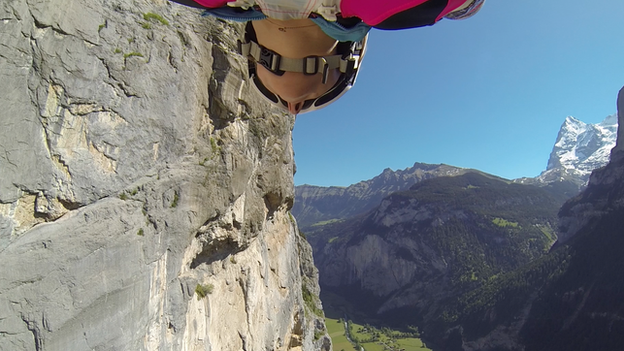
The number of base jumps has increased over the years
"We had the same discussion in our valleys, it should be forbidden.
"Now we have the same thing with the base jumpers, [in fact] we have an increasing number of jumps but the accident rate has not increased."
And while Dr Durrer agrees the activity does carry some very special risks, his medical experience tells him there are many more mundane ones, which fail to attract our attention.
"Couch potatoes, lying on the sofa eating chips and watching TV, now that's a risk for me," he laughs. "At least these base jumpers are fit, they're out in the fresh air."
'Pure Happiness'
Meanwhile, Ellen has landed safely, and is considering another jump.
"That was one of the best jumps I've had," she says. "It feels so good to have a pure release of happiness, everything good in life in that moment, this is life, this is the best."
But she admits, the risk is ever-present in her mind.
"If you're not thinking about the risk every time you jump, you shouldn't be jumping, it's something you need to assess every time," she advises.

Ellen says base jumping brings a rush of pure happiness, but the risks are always on her mind
"But, you know, people don't want to die, people don't come here thinking, 'Oh I'd like to go maybe try to kill myself today'. That's not the goal at all, we come here to live our lives."
Just then, Justine swoops down, and lands successfully. She displays all the signs of a typical base jumper's post jump euphoria.
"Yoohoo, that's what I like, I love it, I love opening my parachute, I love landing, and then the first thing I do is look back at the cliff and think, I'm gonna go back again."
- Published24 April 2014

- Published10 February 2014

- Published4 June 2013
